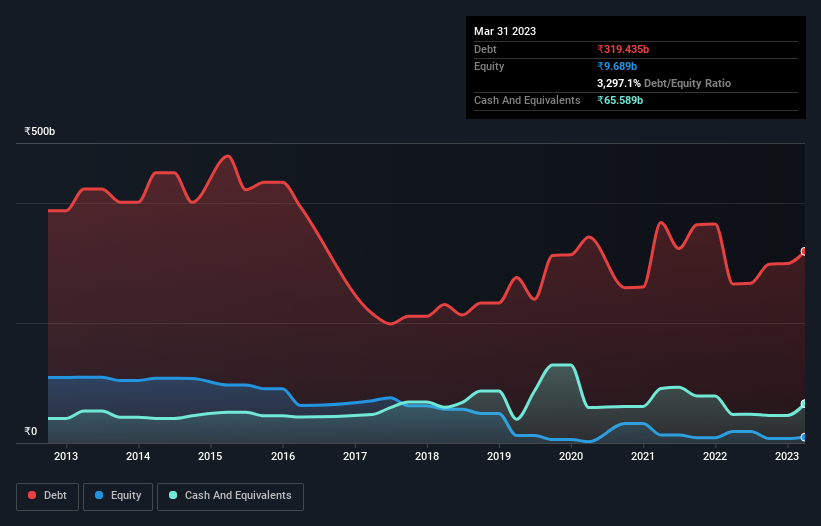- India
- /
- Infrastructure
- /
- NSEI:GMRAIRPORT
GMR Airports Infrastructure (NSE:GMRINFRA) Has No Shortage Of Debt

Legendary fund manager Li Lu (who Charlie Munger backed) once said, 'The biggest investment risk is not the volatility of prices, but whether you will suffer a permanent loss of capital.' So it seems the smart money knows that debt - which is usually involved in bankruptcies - is a very important factor, when you assess how risky a company is. As with many other companies GMR Airports Infrastructure Limited (NSE:GMRINFRA) makes use of debt. But the more important question is: how much risk is that debt creating?
What Risk Does Debt Bring?
Debt is a tool to help businesses grow, but if a business is incapable of paying off its lenders, then it exists at their mercy. If things get really bad, the lenders can take control of the business. However, a more usual (but still expensive) situation is where a company must dilute shareholders at a cheap share price simply to get debt under control. Of course, the upside of debt is that it often represents cheap capital, especially when it replaces dilution in a company with the ability to reinvest at high rates of return. When we think about a company's use of debt, we first look at cash and debt together.
See our latest analysis for GMR Airports Infrastructure
What Is GMR Airports Infrastructure's Debt?
The image below, which you can click on for greater detail, shows that at March 2023 GMR Airports Infrastructure had debt of ₹319.4b, up from ₹265.2b in one year. However, because it has a cash reserve of ₹65.6b, its net debt is less, at about ₹253.8b.

How Healthy Is GMR Airports Infrastructure's Balance Sheet?
The latest balance sheet data shows that GMR Airports Infrastructure had liabilities of ₹90.8b due within a year, and liabilities of ₹340.6b falling due after that. On the other hand, it had cash of ₹65.6b and ₹8.34b worth of receivables due within a year. So its liabilities outweigh the sum of its cash and (near-term) receivables by ₹357.5b.
When you consider that this deficiency exceeds the company's ₹269.2b market capitalization, you might well be inclined to review the balance sheet intently. Hypothetically, extremely heavy dilution would be required if the company were forced to pay down its liabilities by raising capital at the current share price.
We use two main ratios to inform us about debt levels relative to earnings. The first is net debt divided by earnings before interest, tax, depreciation, and amortization (EBITDA), while the second is how many times its earnings before interest and tax (EBIT) covers its interest expense (or its interest cover, for short). The advantage of this approach is that we take into account both the absolute quantum of debt (with net debt to EBITDA) and the actual interest expenses associated with that debt (with its interest cover ratio).
Weak interest cover of 0.29 times and a disturbingly high net debt to EBITDA ratio of 14.7 hit our confidence in GMR Airports Infrastructure like a one-two punch to the gut. The debt burden here is substantial. Worse, GMR Airports Infrastructure's EBIT was down 49% over the last year. If earnings continue to follow that trajectory, paying off that debt load will be harder than convincing us to run a marathon in the rain. When analysing debt levels, the balance sheet is the obvious place to start. But it is future earnings, more than anything, that will determine GMR Airports Infrastructure's ability to maintain a healthy balance sheet going forward. So if you want to see what the professionals think, you might find this free report on analyst profit forecasts to be interesting.
But our final consideration is also important, because a company cannot pay debt with paper profits; it needs cold hard cash. So we always check how much of that EBIT is translated into free cash flow. During the last three years, GMR Airports Infrastructure burned a lot of cash. While that may be a result of expenditure for growth, it does make the debt far more risky.
Our View
On the face of it, GMR Airports Infrastructure's conversion of EBIT to free cash flow left us tentative about the stock, and its EBIT growth rate was no more enticing than the one empty restaurant on the busiest night of the year. And furthermore, its net debt to EBITDA also fails to instill confidence. We should also note that Infrastructure industry companies like GMR Airports Infrastructure commonly do use debt without problems. We think the chances that GMR Airports Infrastructure has too much debt a very significant. To our minds, that means the stock is rather high risk, and probably one to avoid; but to each their own (investing) style. While GMR Airports Infrastructure didn't make a statutory profit in the last year, its positive EBIT suggests that profitability might not be far away. Click here to see if its earnings are heading in the right direction, over the medium term.
When all is said and done, sometimes its easier to focus on companies that don't even need debt. Readers can access a list of growth stocks with zero net debt 100% free, right now.
New: Manage All Your Stock Portfolios in One Place
We've created the ultimate portfolio companion for stock investors, and it's free.
• Connect an unlimited number of Portfolios and see your total in one currency
• Be alerted to new Warning Signs or Risks via email or mobile
• Track the Fair Value of your stocks
Have feedback on this article? Concerned about the content? Get in touch with us directly. Alternatively, email editorial-team (at) simplywallst.com.
This article by Simply Wall St is general in nature. We provide commentary based on historical data and analyst forecasts only using an unbiased methodology and our articles are not intended to be financial advice. It does not constitute a recommendation to buy or sell any stock, and does not take account of your objectives, or your financial situation. We aim to bring you long-term focused analysis driven by fundamental data. Note that our analysis may not factor in the latest price-sensitive company announcements or qualitative material. Simply Wall St has no position in any stocks mentioned.
About NSEI:GMRAIRPORT
Exceptional growth potential very low.
Market Insights
Community Narratives





